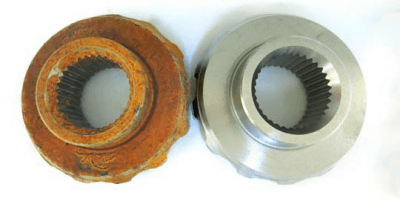How to prevent corrosion on metal parts that are stored outside? Ctemag.com has the answer.
When storage space is at a premium, industrial plants often must turn to outdoor racks or yards in which to let unused equipment or newly finished parts sit temporarily. The main problem with these areas is their exposure to harsh outdoor environments. Snow, rain, wind, high humidity and sometimes even sea spray mercilessly attack equipment or metal parts sitting outside.
Corrosion can be rampant as a result, eating away the integrity of assets that were once in good condition. This is a serious problem for large facilities that have no place to store spare equipment except outside. By the time a spare part is needed, it may be degraded so much that it is not safe to install without further restoration, if it can be used all. Manufacturers that forge or finish valves, die castings, auto parts, or any other type of metal component may be limited on space but need to hold the parts temporarily before their customers can receive them. For these industries, outdoor storage space may be just the answer needed, if only manufacturers could count on rust protection at the same time.
Cortec’s Vapor phase Corrosion Inhibitor Technology provides an effective solution for storing valuable assets outside in the harsh elements. Vapor phase action allows simple and relatively easy protection of large internal void spaces and intricate surfaces through the use of VpCI emitting materials.
These VpCI products work by releasing Vapor phase Corrosion Inhibitors into the air. When trapped inside an enclosure, the inhibitors adsorb, or “stick,” to metal surfaces, creating an invisible molecular layer that protects against the attack of oxygen, moisture, and chlorides—key elements that encourage corrosion. When the enclosure is opened, the VpCI molecules begin to leave the surface on their own, so that no special cleaning is required to remove the protective layer.
Cortec has integrated Vapor phase Corrosion Inhibitor Technology into a variety of different packaging materials to provide flexible and effective protection solutions for metal parts and equipment of all sizes. For the outside of equipment or parts, VpCI film such as MilCorr and VpCI-126 HPUV combine corrosion protection with high
durability characteristics to withstand the attacks of wind, rain, snow, sun and sea spray. On the inside of components, VpCI-emitting material such as VpCI foam, pouches, emitters or even papers provide an extra source of VpCI protection for larger internal spaces needing protection, with dosage based on volume.
Some examples of how VpCI materials can be applied include the following:
• Shrink-wrapping a set of newly finished components in VpCI-126 HPUV film with a Bio-Pad or VpCI-130 Series
foam inside for extra protection
• Interleaving layers of automotive parts with VpCI-146 paper and enclosing the entire crate in VpCI-126 HPUV
• Placing EcoPouches, VpCI-308 Pouches, or VpCI-309 Pouches (depending on metal types) in strategic places in and around the voids of large process equipment (e.g., boilers or chillers) and shrink-wrapping the entire module in MilCorr or VpCI-126 HPUV, depending on the harshness and length of the preservation period
• Shrink-wrapping heavy equipment in MilCorr® film for temporary storage, with VpCI-105 or VpCI-111 emitters placed inside near electrical components
The mix and match options go on and on. Constant monitoring is not required, although periodic checks once or twice a year can be helpful to make sure the protection system is still intact. When the equipment is needed again, it can be easily unwrapped without the typical cleaning and degreasing that would be required if using traditional rust preventatives. Often, the parts can be immediately put into use.
Vapor phase Corrosion Inhibitor Technology has been used to protect parts and equipment in some of the harshest environments around the world. It is a simple, economical, and effective way to transform an outdoor storage space into a safe haven for metal parts and equipment.
















































